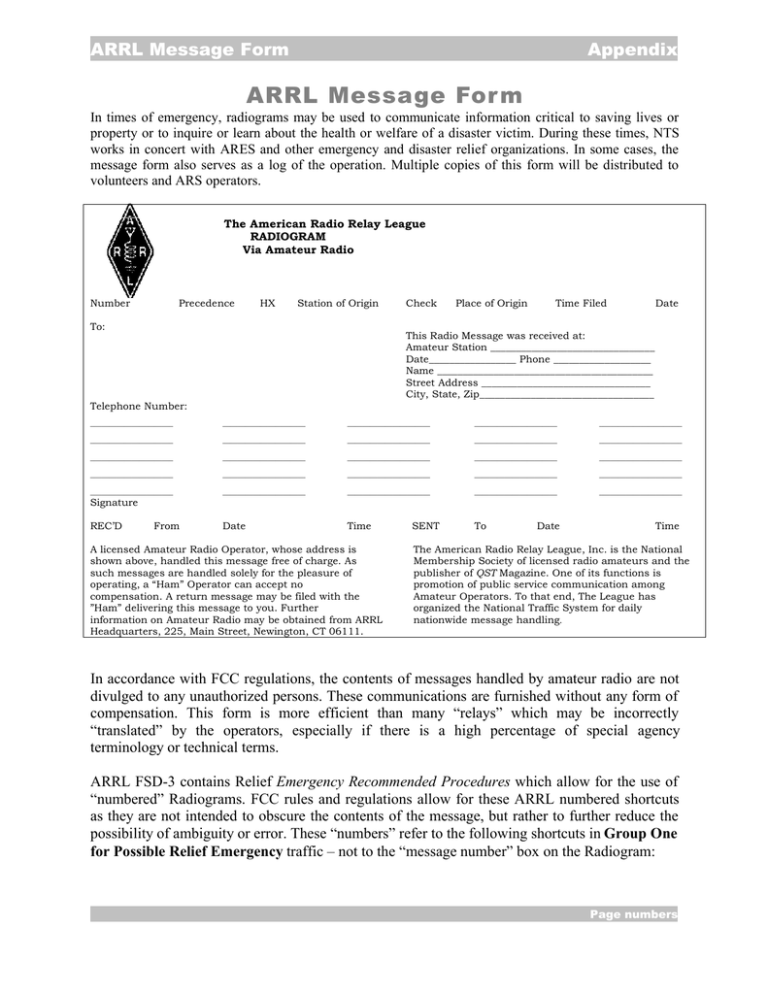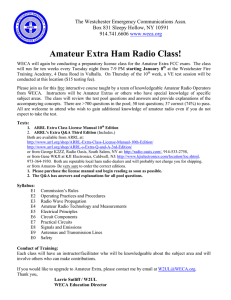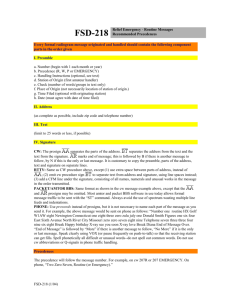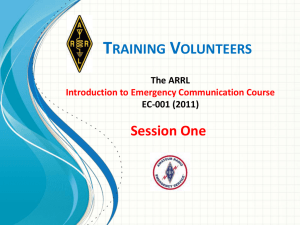ARRL Message Form - Bloomington Amateur Radio Club
advertisement

ARRL Message Form Appendix ARRL Message For m In times of emergency, radiograms may be used to communicate information critical to saving lives or property or to inquire or learn about the health or welfare of a disaster victim. During these times, NTS works in concert with ARES and other emergency and disaster relief organizations. In some cases, the message form also serves as a log of the operation. Multiple copies of this form will be distributed to volunteers and ARS operators. The American Radio Relay League RADIOGRAM Via Amateur Radio Number Precedence HX Station of Origin To: Check Place of Origin Time Filed Date This Radio Message was received at: Amateur Station ________________________________ Date_________________ Phone ___________________ Name __________________________________________ Street Address _________________________________ City, State, Zip__________________________________ Telephone Number: ______________________ ______________________ ______________________ ______________________ ______________________ ______________________ ______________________ ______________________ ______________________ ______________________ ______________________ ______________________ ______________________ ______________________ ______________________ ______________________ ______________________ ______________________ ______________________ ______________________ ______________________ ______________________ ______________________ ______________________ ______________________ Date Time To Signature REC’D From A licensed Amateur Radio Operator, whose address is shown above, handled this message free of charge. As such messages are handled solely for the pleasure of operating, a “Ham” Operator can accept no compensation. A return message may be filed with the ”Ham” delivering this message to you. Further information on Amateur Radio may be obtained from ARRL Headquarters, 225, Main Street, Newington, CT 06111. SENT Date Time The American Radio Relay League, Inc. is the National Membership Society of licensed radio amateurs and the publisher of QST Magazine. One of its functions is promotion of public service communication among Amateur Operators. To that end, The League has organized the National Traffic System for daily nationwide message handling. In accordance with FCC regulations, the contents of messages handled by amateur radio are not divulged to any unauthorized persons. These communications are furnished without any form of compensation. This form is more efficient than many “relays” which may be incorrectly “translated” by the operators, especially if there is a high percentage of special agency terminology or technical terms. ARRL FSD-3 contains Relief Emergency Recommended Procedures which allow for the use of “numbered” Radiograms. FCC rules and regulations allow for these ARRL numbered shortcuts as they are not intended to obscure the contents of the message, but rather to further reduce the possibility of ambiguity or error. These “numbers” refer to the following shortcuts in Group One for Possible Relief Emergency traffic – not to the “message number” box on the Radiogram: Page numbers Appendix ARRL Message Form ARRL Message Format Instructions for NTS Traffic Handling The letters ARL are inserted in the preamble in the check count and in the text before spelled out numbers or numbers in numeral form which represent text from Group One. Example: NR 20 E W9INL ARL 9 BLOOMINGTON IN. MAY 15 MONROE COUNTY EMA W 7TH ST PHONE 349-2546 ARL EIGHT 2 ARL THIRTEEN ARL SIXTEEN RBB SHELTER JOHN . In plain text, this message reads: Message number 20, Precedence Emergency, From W9INL, Check is 9 words, location Bloomington, IN, May 15, for Monroe County EMA at W 7th, telephone 349-2546. Text: need 2 additional mobile or portable units at this location, a medical emergency exists here, property damage very severe in this area RBB Shelter, Signed, John. Group One—For Possible Relief Emergency Use ONE TWO. THREE. FOUR\ FIVE SIX SEVEN. EIGHT NINE. TEN ELEVEN TWELVE THIRTEEN FOURTEEN FIFTEEN SIXTEEN SEVENTEEN EIGHTEEN NINETEEN TWENTY TWENTY ONE TWENTY TWO TWENTY THREE TWENTY FOUR TWENTY FIVE TWENTY SIX Everyone safe here. Please don't worry. Coming home as soon as possible. Am in _____ hospital. Receiving excellent care and recovering fine. Only slight property damage here. Do not be concerned about disaster reports. Am moving to new location. Send no further mail or communication. Will inform you of new address when relocated. Will contact you as soon as possible. Please reply by Amateur Radio through the amateur delivering this message. Need additional ____ mobile or portable equipment for immediate emergency use. Additional _____ radio operators needed to assist with emergency at this location. Please contact _____. Advise to standby and provide further emergency information, instructions or assistance. Establish Amateur Radio emergency communications with _____ on _____ MHz. Anxious to hear from you. No word in some time. Please contact me as soon as possible. Medical emergency situation exits here. Situation here becoming critical. Losses and damage from ____ increasing. Please advise your condition and what help is needed. Property damage very severe in this area. REACT communications services also available. Establish REACT communication with _____ on channel _____. Please contact me as soon as possible at _____. Request health and welfare report on _____ . (State name, address and telephone number.) Temporarily stranded. Will need some assistance. Please contact me at _____. Search and Rescue assistance is needed by local authorities here. Advise availability. Need accurate information on the extent and type of conditions now existing at your location. Please furnish this information and reply without delay. Report at once the accessibility and best way to reach your location. Evacuation of residents from this area urgently needed. Advise plans for help. Furnish as soon as possible the weather conditions at your location. Help and care for evacuation of sick and injured from this location needed at once. . Emergency/priority messages originating from official sources must carry the signature of the originating official. Page numbers ARRL Message Form Appendix ARRL Radiogram Message Form Contents Date of origin. The address should be complete and include a telephone number if known. The text should be short and to the point, and the signature should contain not only the name of the person sending the message but his title or connection also, if any. Number. This is the number of the message. Select a start point for “1.” Precedence. Emergency—Any message having life and death urgency to any person or group of persons. This includes official messages of welfare agencies during emergencies requesting supplies, materials, or instructions vital to relief of stricken populace in emergency areas. These are handled before Priority, Welfare, or Routine traffic. Rarely used during non-emergency periods. Priority—Important messages having a specific time limit: official messages not covered in the Emergency category, press dispatches and other emergency-related traffic not of the utmost urgency, personal or official notification of death or injury in a disaster. These are handled after Emergency traffic but before Welfare or Routine traffic. Welfare—A message that is either; an inquiry as to the health of an individual in the disaster area or an advisory or reply from the disaster area that indicates all is well should carry this precedence. These messages are handled after Emergency and Priority traffic, but before Routine. Routine—Most traffic in normal times will bear this designation. In disaster situations, traffic labeled Routine should be handled last, or not at all when circuits are busy with Emergency, Priority, or Welfare traffic. Handling Instructions. Optional. This section is not regularly used in Emergency Communications, but once inserted is mandatory with all relaying stations. The following definitions apply: HXA--(Followed by number) Collect landline delivery authorized by addressee within...miles. (If no number, authorization is unlimited.) HXB--(Followed by number) Cancel message if not delivered within...hours of filing time; service originating station. HXC—Report date and time of delivery (TOD) to originating station. HXD—Report to originating station the identity of station from which received, plus date and time. Report identity of station to which relayed, plus date and time, or if delivered report date, time and method of delivery. HXE—Delivering station get reply from addressee, originate message back. HXF--(Followed by number.) Hold delivery until...(date). HXG—Delivery by mail or landline toll call not required. If toll or other expense involved, cancel message and service originating station. Station of Origin. The first amateur handler. (see Place of Origin) Check. The number of words/groups in text only. Place of Origin. City or town where message is sent. Not necessarily location of Station of Origin. Time Filed. The time message is filed. Optional with originating station. Address. Complete address including ZIP code of person who will receive this message. Telephone Number. Complete telephone number including area code of person who will receive the message. Text. Limit message to 25 words or less, if possible. Note that “X”, when used in the text as punctuation, counts as a word for Check.. Signature. The name of the person sending the message. It does not count as a word. RCV’D (Received). During an emergency, an official who receives the message should sign in the box. Otherwise, the amateur who receives the message signs. Message forms may vary, so if this area is not on the form, sign on the back of the form. Sent. During an emergency, an official who sends the message should sign in the box. Otherwise, the amateur who sends the message signs. Message forms may vary, so if this area is not on the form, sign on the back of the form. Page numbers


